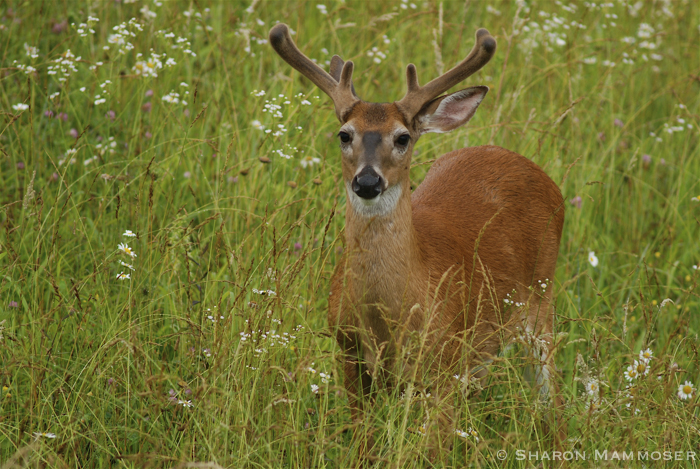 I suspect that no matter where you live, you’ve probably seen deer. They are a common mammal throughout the United States (though are not commonly seen in California, Utah and Nevada) and are native to every continent except Antarctica and Australia. Like many common animals though, how much do you really know about them?
I suspect that no matter where you live, you’ve probably seen deer. They are a common mammal throughout the United States (though are not commonly seen in California, Utah and Nevada) and are native to every continent except Antarctica and Australia. Like many common animals though, how much do you really know about them?
Here are some interesting facts about our common Whitetail Deer:
1. If you’ve ever seen a deer run away from you, you may have noticed that they hold their white tails up, like a flag. This is how they got their common name. They do this to let other deer know that they’ve sensed danger nearby. Their tail raising is often accompanied by snorting and sometimes, stomping of one of their legs. All of these things are signals to other deer.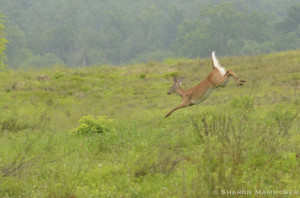
2. Deer, like moose and elk grow antlers. These are different from horns in that antlers are shed each year, in December or January. Horns are permanent. The reason you don’t find many antlers among the leaves is because animals like mice and other rodents come and gnaw on the antlers for their calcium, eventually “recycling” the antlers. (To read more about antlers vs. horns, CLICK HERE)
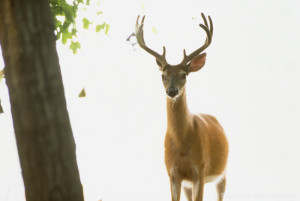 3. Deer antlers are the fastest growing tissue on earth! Whitetail deer antlers might grow up to 1/2 inch per day! The antlers start growing in the spring and continue through summer. Growth is regulated by hormones and controlled by the number of daylight hours. At first the antlers are covered with what is called velvet–this is made up of a network of blood vessels and nerves and is sensitive. As fall approaches, the velvet will be shed, showing smooth bone beneath.
3. Deer antlers are the fastest growing tissue on earth! Whitetail deer antlers might grow up to 1/2 inch per day! The antlers start growing in the spring and continue through summer. Growth is regulated by hormones and controlled by the number of daylight hours. At first the antlers are covered with what is called velvet–this is made up of a network of blood vessels and nerves and is sensitive. As fall approaches, the velvet will be shed, showing smooth bone beneath.
4. Male deer are called bucks or stags. Only male whitetail deer grow antlers. They have them to impress the females. In the fall males will rub their antlers on trees to mark their territory. These are referred to as “buck rubs,” and can be a way to determine if bucks live in an area. (Do you know which is the only member of the deer family that BOTH the male and female grow antlers? Click HERE to learn the answer.)
5. October through early December is considered “the rut.” This is their breeding season. It is during this time that males often have confrontations to establish dominance. They have dueling contests, using their antlers to fight against another male deer. During this time their necks may swell up to twice their normal diameter. (On a recent day, I was able to witness the meeting of two bucks fighting with their antlers! If you’d like, you can read about it and see pictures from it HERE. ) During the rut, deer may wander into areas where they don’t normally travel, including roads and residential areas. They can be aggressive during this time so it is best to keep a safe distance.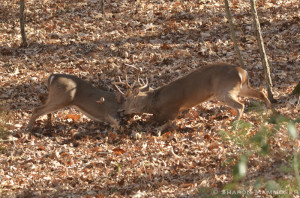
6. Many people believe you can tell the age of a male deer by the size of its rack, but this is not necessarily true as other factors come into play, including the condition of their mothers. Age, nutrition and genetics play a role in the size of a buck’s antlers. A fascinating fact about their antlers is that an injury to a leg –such as a collision with a vehicle–is likely to affect their antlers. If a deer injures a front leg, the antler on the same side as the injury could be affected by a deformity. If however, the deer has a hind leg injury, the antler on the opposite side as the injury could be affected. The deformity may last for consecutive years depending on the injury. Other things that may cause deformities happen while the antlers are still in the velvet, such as breaking them, getting them caught on a branch or other obstacle, and fighting. If a buck is getting proper nutrition and is healthy, his rack may get larger each year until he reaches the age of 6 1/2.
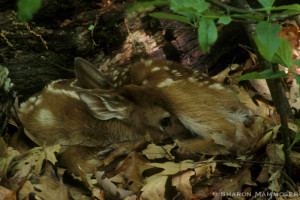 7. Young deer are called fawns. When they are born, fawns don’t have a strong scent and their dotted coats provide excellent camouflage. Their main means of defense at this time is lying still. Many well-intentioned people discover fawns in the spring and, thinking they have been abandoned, pick them up and seek help from a wildlife rehabilitater. This is a terrible idea! PLEASE don’t do this, as the mother deer is usually close by and watching. She will return to feed the fawn during the day and keeps an eye from a distance. Fawns that remain motionless avoid notice from potential predators; those that get up cannot outrun their predators and are sure to be caught. If a person touches a fawn, or causes it to get up and run, the fawn is put at great risk then. (To read about an encounter I had with a fawn, CLICK HERE.)
7. Young deer are called fawns. When they are born, fawns don’t have a strong scent and their dotted coats provide excellent camouflage. Their main means of defense at this time is lying still. Many well-intentioned people discover fawns in the spring and, thinking they have been abandoned, pick them up and seek help from a wildlife rehabilitater. This is a terrible idea! PLEASE don’t do this, as the mother deer is usually close by and watching. She will return to feed the fawn during the day and keeps an eye from a distance. Fawns that remain motionless avoid notice from potential predators; those that get up cannot outrun their predators and are sure to be caught. If a person touches a fawn, or causes it to get up and run, the fawn is put at great risk then. (To read about an encounter I had with a fawn, CLICK HERE.)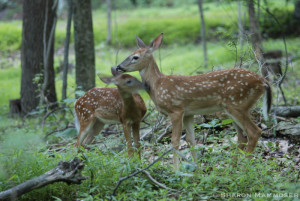
8. Deer can run up to 40mph. They can jump 10 feet and can swim up to 13mph.
9. The average deer lives less than 5 years, and probably closer to just two with the maximum being about 15. This would have to be from a deer in an area where hunting is not allowed. Deer become sexually mature at one and a half years old but do not reach full size until they are 4-5 years old. The average weight of an adult is 100-350 pounds, with males being larger than females.
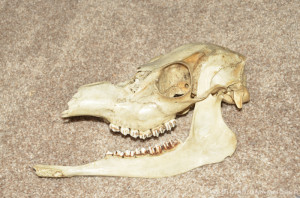
10 Deer are herbivores, meaning they eat only plant material. They eat young leaves, stems, shoots, mushrooms, acorns, other fruit and, as most any gardener will tell you, lots of flowers and vegetation we love to plant in our gardens and yards! Unlike carnivores, with sharp front incisors, deer do not have teeth in the front of their mouths, except little ones that they use to break off branches. As ruminants (cud chewers) they have a four–chambered stomach!
11. Deer have fabulous hearing, as you can likely tell by looking at their large ears. There are many muscles attached to them, allowing the deer to move each independently. They also have a great sense of smell and eyes on the sides of their heads to give them a 310 degree view, looking for potential predators like wolves, bobcats and coyotes. 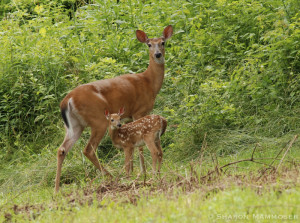
Resources:


Antlers aren’t the fastest growing tissue on earth but rather the fastest growing tiasue on a mammal. For example, bamboo can grow at a rate of up to 3ft per day.
Hey Chris, thanks for the clarification! I did not know bamboo can grow that fast!